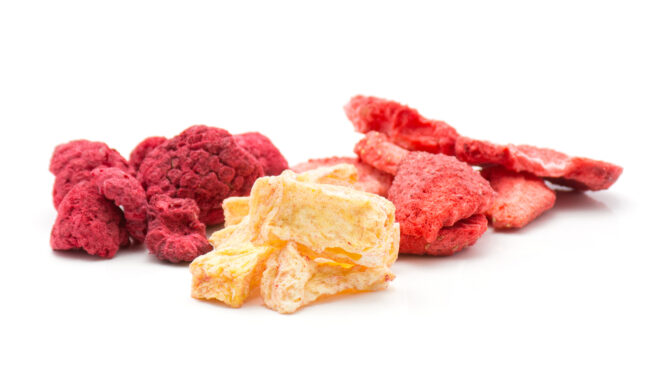At-home freeze drying: A growing trend with food safety concerns
As the popularity of at-home freeze drying continues to grow, so do questions about its safety.
Once primarily a commercial food preservation technique, freeze drying has made its way into homes, with consumers hoping to create long-lasting, shelf-stable foods. However, many home users lack the knowledge needed to ensure the safety of freeze-dried foods. Dr. Mary-Grace Danao, a Research Associate Professor at the University of Nebraska–Lincoln’s Food Processing Center, shared valuable insights into the safety challenges and best practices for at-home freeze drying.
The growing trend of at-home freeze drying

Research Associate Professor
at the UNL’s Food Processing Center
According to Danao, at-home freeze drying has become a “huge thing.” She notes that consumer interest in preserving food is at an all-time high, driven by trends like do-it-yourself food preparation and long-term food storage. Organizations such as the University of Georgia’s National Center for Home Food Preservation have also seen increased interest in freeze drying. However, despite its rising popularity, there is limited guidance available for consumers.
Understanding the freeze-drying process
Freeze drying, also known as lyophilization, is a process that removes moisture from food by freezing it and then using a vacuum to sublimate the ice directly into vapor. Danao said the process consists of three stages:
- Freezing: Foods must be thoroughly frozen, typically at temperatures of -20 to -30 degrees F. Proper slicing is critical — meats should be thinly sliced, and fruits or vegetables should be evenly cut to ensure uniform drying.
- Sublimation: The frozen food is placed in a vacuum, and heat is applied to turn ice crystals into vapor. This stage removes more than 90 percent of the moisture.
- Desorption: Additional heat is applied to remove any remaining moisture, ensuring a stable, shelf-ready product.
At-home freeze dryers simplify the process with automated settings, but Danao cautions that these machines often lack adequate monitoring tools.
“Once the dryer tells you everything is done, it’s up to the consumer to check for doneness,” she said.
Without proper inspection, consumers may leave moisture pockets that could promote microbial growth.
The importance of water activity
Danao emphasized that water activity — not just moisture content — is key to food safety.
“Water activity measures the amount of water available for microbial growth,” she said.
Foods with water activity below 0.6 are generally safe from yeast, mold and bacterial growth. However, many consumers are unaware of this distinction and may mistakenly believe their foods are safe based solely on dryness.
Common food safety risks
Several foodborne pathogens pose risks during freeze drying:
- Meat products: Salmonella, E. coli and Listeria are common hazards in freeze-dried meats.
- Fruits and vegetables: Listeria can be introduced during slicing, and Salmonella contamination is a concern.

must be packaged in moisture-proof,
hermetically sealed containers.
Danao warns that at-home freeze drying is not a kill step. “If pathogens are present in the food before freeze drying, they may still be present in the dried product,” she said.
For high-risk foods, such as meats, pre-cooking or using other kill steps before freeze drying is advisable.
The dangers of rehydration
One of the most overlooked risks in at-home freeze drying is rehydration. While freeze-dried foods are shelf-stable in their dried form, rehydrating them reintroduces moisture and potential hazards.
“Once rehydrated, foods are no longer shelf-stable they should be refrigerated if not consumed immediately,” Danao said.
For example, freeze-dried fruits like strawberries or bananas may seem safe. However, once water is added back, they become perishable and susceptible to microbial growth. Consumers must handle these foods as they would any fresh produce.
Challenges with cleaning freeze dryers
Cleaning and sanitizing freeze dryers is another critical food safety concern. Danao said that many at-home machines are difficult to clean thoroughly. Some older models allowed users to detach shelves and clean them separately, but newer models often do not have this feature.
“If shelves aren’t properly cleaned, there’s potential for uneven heating and contamination,” she said.
Additionally, moisture from freeze drying can create ice layers inside the machine, posing electrical hazards if wires are exposed.
Commercial freeze dryers, on the other hand, are often designed with hollow, stainless-steel shelves that allow for complete wash-downs. At-home users should take extra care to wipe down all components and ensure no residue remains.
Selecting the right equipment
With freeze dryers ranging from $2,000 to $7,000, consumers should be cautious when purchasing lower-cost models. Danao warns that some inexpensive devices marketed as freeze dryers are actually just food dehydrators. These machines may not achieve the necessary vacuum or low temperatures required for true freeze drying, leading to improperly preserved foods.
Educational gaps and the need for guidance
Currently, few resources are available to guide consumers on safe at-home freeze drying. Danao and her colleagues at the University of Nebraska–Lincoln and the University of Georgia are working on developing educational materials, but more research and public outreach are needed.
“Manufacturers could do a better job of educating consumers,” Danao says. “Consumers need to know what foods are safe to freeze dry, how to monitor the process, and what to do once foods are rehydrated.”
Best practices for at-home freeze drying
To help ensure safety, Danao recommends the following best practices:
- Start with fresh, high-quality ingredients: Use wholesome foods to reduce the risk of introducing pathogens.
- Slice uniformly: Ensure even drying by slicing foods evenly.
- Practice good hygiene: Avoid cross-contamination by thoroughly washing hands, tools and surfaces.
- Monitor doneness: Perform a knife test to check for moisture pockets inside the food.
- Use a water activity meter: Invest in a meter to measure water activity and ensure safety.
- Refrigerate rehydrated foods: Treat rehydrated foods as perishable and store leftovers properly.
- Clean thoroughly: Pay close attention to cleaning all components of the freeze dryer to prevent contamination.
As interest in at-home freeze drying continues to grow, so does the need for comprehensive safety education. Danao and other experts are working to close the knowledge gap and provide consumers with the tools they need to safely enjoy freeze-dried foods.
By understanding the risks and following best practices, consumers can confidently navigate the world of at-home freeze drying, preserving foods that are not only shelf-stable but also safe to eat.
(To sign up for a free subscription to Food Safety News, click here.)
Source: https://www.foodsafetynews.com/2025/02/at-home-freeze-drying-a-growing-trend-with-food-safety-concerns/
Anyone can join.
Anyone can contribute.
Anyone can become informed about their world.
"United We Stand" Click Here To Create Your Personal Citizen Journalist Account Today, Be Sure To Invite Your Friends.
Before It’s News® is a community of individuals who report on what’s going on around them, from all around the world. Anyone can join. Anyone can contribute. Anyone can become informed about their world. "United We Stand" Click Here To Create Your Personal Citizen Journalist Account Today, Be Sure To Invite Your Friends.
LION'S MANE PRODUCT
Try Our Lion’s Mane WHOLE MIND Nootropic Blend 60 Capsules
Mushrooms are having a moment. One fabulous fungus in particular, lion’s mane, may help improve memory, depression and anxiety symptoms. They are also an excellent source of nutrients that show promise as a therapy for dementia, and other neurodegenerative diseases. If you’re living with anxiety or depression, you may be curious about all the therapy options out there — including the natural ones.Our Lion’s Mane WHOLE MIND Nootropic Blend has been formulated to utilize the potency of Lion’s mane but also include the benefits of four other Highly Beneficial Mushrooms. Synergistically, they work together to Build your health through improving cognitive function and immunity regardless of your age. Our Nootropic not only improves your Cognitive Function and Activates your Immune System, but it benefits growth of Essential Gut Flora, further enhancing your Vitality.
Our Formula includes: Lion’s Mane Mushrooms which Increase Brain Power through nerve growth, lessen anxiety, reduce depression, and improve concentration. Its an excellent adaptogen, promotes sleep and improves immunity. Shiitake Mushrooms which Fight cancer cells and infectious disease, boost the immune system, promotes brain function, and serves as a source of B vitamins. Maitake Mushrooms which regulate blood sugar levels of diabetics, reduce hypertension and boosts the immune system. Reishi Mushrooms which Fight inflammation, liver disease, fatigue, tumor growth and cancer. They Improve skin disorders and soothes digestive problems, stomach ulcers and leaky gut syndrome. Chaga Mushrooms which have anti-aging effects, boost immune function, improve stamina and athletic performance, even act as a natural aphrodisiac, fighting diabetes and improving liver function. Try Our Lion’s Mane WHOLE MIND Nootropic Blend 60 Capsules Today. Be 100% Satisfied or Receive a Full Money Back Guarantee. Order Yours Today by Following This Link.






